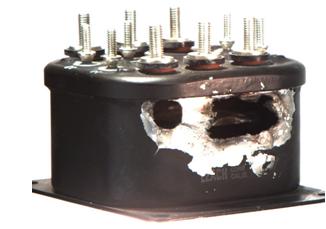RS Classic: What Do You Know About Tin Whiskers?
>> Friday, July 2, 2010

I have a specific reason for redoing this one right now. I'll repost this because it's (I think) a good intro into the subject and carry forward over the next days as I see fit.
On today’s menu is another real something that has tremendous potential in the plot of a book (particularly science fiction, though any contemporary book could use it): tin whiskers.
Never heard of them, you say? Well, get some popcorn and sit back. Tin whiskers are cool, they’re scary, and we might be hearing much more about these before you know it. See, two years ago, I had never heard of them either. Last year [2007], I wrote a paper on them (You can also find the presentation). The subject is fascinating.
See, certain metals and alloys, particularly when used as a plating, will start to grow slim little hairs of metal. One of them is tin. Most never get more than a few mm long, but others have grown cm long under the right circumstances. Here’s a great picture of some we found in avionics boxes used to control reaction jets and aerosurfaces on the Orbiter (see page 5 of the presentation linked). If they bridge a gap with some power, but not too much, they just fuse and evaporate. If it’s a data connection, they can change a control, turn something on that shouldn’t be, for instance. But, if it has power and the conditions are right, you can get something call metal vapor arcing that will make a big unholy mess. I have some pictures in my linked presentation and paper, but there are other examples at the source for all things metal whiskery: Goddard’s Tin Whisker Website (where you can find the paper and presentation I wrote here and here). For the science minded, this is a treasure trove of data, stories, pictures, videos, pointers, etc. of all kinds of metal whiskers, well worth wandering through. All photos here link to the Goddard website.
Tin isn’t the only metal. Zinc and cadmium are also prone to whiskering. Zinc whiskering is becoming a serious concern in computer server facilities. Zinc whisker grows from the galvanized metal shielding on the underside of floor tiles in these facilities. When they go to upgrade or do work below, the floor tiles are lifted up and often shoved over the other floor tiles, shearing the unseen whiskers off and letting them drop into the crawlspace below. When they restart the system, the ventilation, which often flows underneath the floor, picks these whiskers up and sends them right into the computers. Huge, highly redundant server systems have been disabled this way. Really, read about it here or you can just stumble over many resources at the Goddard Tin Whisker Website. They’ve even found lead whiskers, gold whiskers and silver whiskers (though the latter is a different mechanism that grows silver whiskers like mad in a suphur rich environment. See this).
No one’s entirely sure what causes metal whiskers or what factors slow or speed the process. Whiskers may not grow for years and then grow very fast. Others might grow quickly from the beginning.
OK, so this is all cool in a geeky kind of way. So, how is this useful for fiction? Well, whiskers are an effective way to screw up all kinds of redundancy, which is frequently used to mitigate risk for space craft, with one mechanism. It’s one reason why NASA has severe restrictions on the use of pure tin plating. But, it’s not necessarily on the minds of regular people either, so this may not even be on the radar for commercial electronics. That makes it a potential factor in electric cars or planes or, in fact, anything that has critical functions that is governed by electronics. And remember, though we may come up with some way of beating them this time, a generation from now, we might forget about them all over again and have to learn it all over.





.jpg)











.jpg)



WOW, never knew.
That's pretty cool.
Sounds like the plot of a fantasy novel. Wait...
Actually, sandwiching a layer of Ni between the Cu and Sn can act as enough of a diffusion barrier for the copper (so as to retard the formation of Cu6Sn5 at the Cu-Sn interface, which causes the stress in the first place) to mitigate the formation of tin whiskers (intermetallics.) This is pretty effective at room temperature.
According to the latest research I've seen (I still follow this), that "may" delay onset. It is not considered (by the experts I know) definitive. When I first started studying this, most seem to think stress was "the" factor. Now, many things are seen as contributors and the definitive mechanism for why they form is still up in the air. On the GSFC website I have linked they have dozens of papers and publications, many of which challenge mitigations we used to think as fool proof.
It is very difficult to keep up with this topic. When I presented this paper in 2007, one of the material experts responsible for the Space Station materials provided a correction, that it wasn't tin and some tin alloys, but just pure tin. Turns out he wasn't aware of the latest.
Which I provide to demonstrate that I'm not necessarily aware of the latest either. I try to keep an ear out, but I'm quite certain much of what I understood is outdated. I do encourage anyone interested to check out the Goddard website.
Could you do a sub-plot about a company who cut-corners and caused the trouble of the crew in the story? You can explore the politics of space exploration, if you have the room.
Could problems be avoided with constant inspections and maintenance or are the whiskers so fine that they are hard to clean.
This quote from wikipedia is cool and scary "At frequencies above 6 GHz or in fast digital circuits, tin whiskers can act like miniature antennas, affecting the circuit impedance and causing reflections".